Once netted, breams stop all struggle and pose handsomely with all the
fins pulled upright. They are strong creature and will not easily die even
after prolonged fight and photo session. However please do note breams
of 40cms are 6-7 years old at least. And they are mostly females (they
change sex as they mature) therefore valuable source of offsprings - handle
with care.,
Breams are fish that demands a lot. We flyfishers face challenges how to
erase the presence of line, rod, and ourselves. And how to imitate not
only the shape but the movement of their natural bait. Big frustrations
work only as an appetizer and a fish caught is true accomplishments. Hope you join me to share the excitement this superb game fish has to offer.
- Advanced techniques
Fighting and releasing
The next moment your reel will start a violent back spin and the fly line
will disappear to the horizon - is the story I would love to tell but cannot.
Though breams are powerful they lack the speed of bonefish and they never
jump. Their run shows determination but is mostly controllable with angler's
rod and foot work. Tippet of 7lb breaking strength is enough to subdue
their torque so you mostly do not need to rely on the reel, much less backing.
Hand line them swiftly to enjoy the best of their power and release quickly.
To avoid spooking the fish, gentle presentation to 2 or 3 meters in front
of the target is the best. But very often flyfishers, and especially those
competent casters, tend to cast directly to the head of the fish. A simple
technique to avoid that is to look at not the fish but the exact point
you want your fly to hit. This too needs a bit of getting used to but you
will soon be amazed how effectively your eyes can adjust your final delivery
to the good side of the critical 2 or 3 meters.
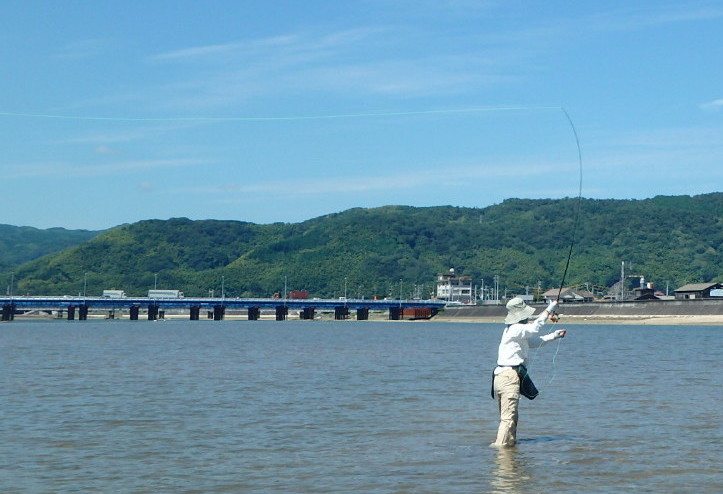
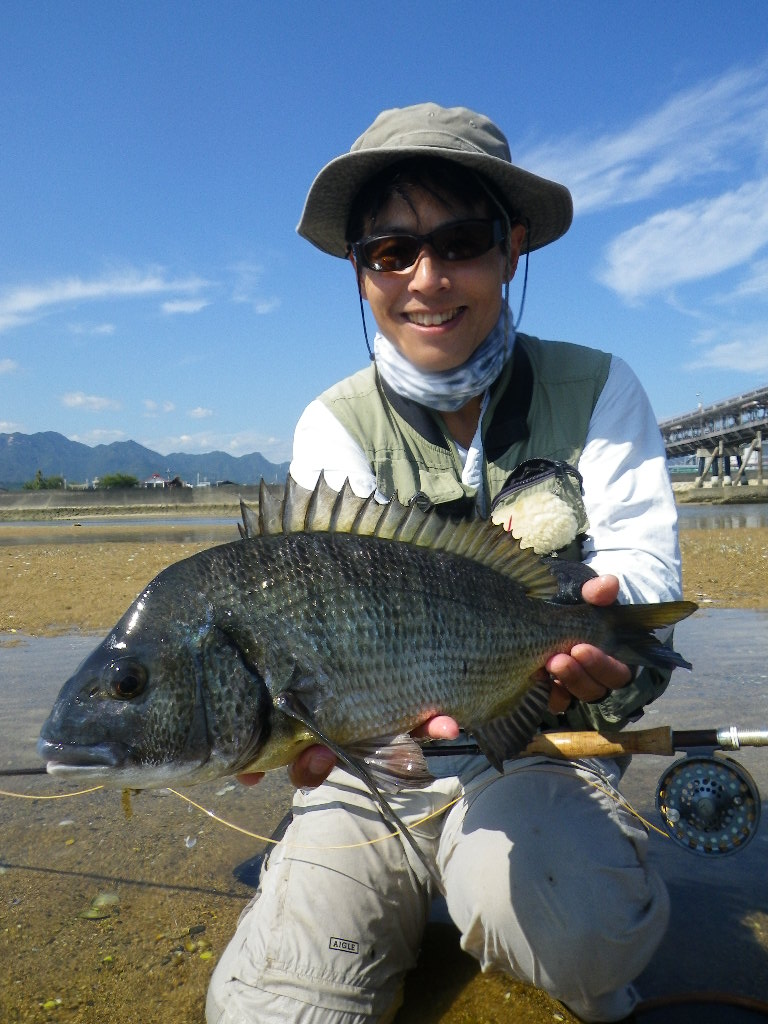
Meanwhile, when the condition is ideal, a less experienced angler tend
to fall into a trap of different nature. Human eyes tend to focus on something
visible, and become reluctant to look farther. You might see a pair of
rock, drifting seaweed, or a can of coke half buried in the sand but they
are not what you are after. You must willfully look farther, for the sign of your target before they come too close.
You must spot the fish before the fish spot you. To succeed in that, you
must watch over the field wide and vague, as opposed to checking out every smudge or spots point by point. Once
you get used to that, push your coverage +3meters farther. If your eyes
locates a rock 15meters away, great, then push your eyes 18meters radius.
Once you have gained a scouting field of 25meters you can spot any fish
whether it is 10m or 20meters away. In sighting, far sighted doubles near sighted. Lastly, the simple advice in training your sighting skill is Never cast till you see.
In a windy condition, you should take a position to have the wind on your
back. The surface of the water, pushed by the wind works like a lens through which you can scout under water. Much easier than standing against the wind and looking into the break of the waves.
Of course the most powerful ally of sight fishing is the sun, and we shouldn't
be giving up the ideal positioning to the sun for a little twists of the
wind. But once the wind goes stronger than 5m/s, sighting against wind
becomes a real challenge. If the wind forces you to fish against the sun,
one good tactics is to position yourself so that you can place dark coloured buildings, trees, or even mountains in the distance
on the far side of your sighting scope. That removes the glare off of the water surface and makes sighting considerably
easier.
Casting
So you spotted your fish and the fly is in your hand. But before you cast,
do look around once again. The fish nearest to you must be the fish you
cast to. Never overline a fish even if that's not your target. One fish
spooked is one whole school spooked. Do not cast until you confirm there are no fish between you and the target.
Most bream games take place within 15meter's radius. You rarely cast the
full line. 15meter's line plus leader and tippet, 20meters in total is
all you must manage on a straight line. 7wt rod, or 6wt with good punch
will do the job.

Identifying the target
As your sighting skill improves, you start see more and more, to the extent
of being able to tell their exact movement and feeding actions. Do not
cast yet. The next step is to identify your target.
As far as breams go, those cruising near the surface are not in a feeding
mode so best be ignored, or you run a risk of spooking the sunbather which
spooks all the other member of the school. Look for those patrolling the shallow bottom, moving zig zag with their
heads tilting down. They are the ones feeding therefore worth targetting at.
No doubt, big blue sky presents the best sighting opportunities but not
all days are like that. One should be prepared for those all too frequent
less than perfect days.
A very easy thing is to look for and remember the stretch where even, light coloured floor spreads.
Those places are easier to sight even under low light. And focus your attention to the shallowest part of the water as you can collect other sources of information such as finning and tailing.
Those fish that venture into the shallow have reasons to do so - to feed.
Very often, such focused approach does pay up its dividends.
Sighting
Importance of the sighting ability can never be exaggerated. Anglers who can see fish not only catch multiple more fish than those who cannot, but it also gives that deep sense of satisfaction as you see every step of the game for yourself.
It is often said and I do agree with it - sighting ability is not a talent
for the special few. And it is not directly linked with your eye's vision.
What makes difference is a pair of good polaroid glasses, few simple knowledge,
and of course plenty of training.
Taking a position so you have the sun on your back is something anyone can do. Naturally the sun travels on the set route
and an angler should adjust his fishing direction accordingly - so long
as other elements allow you.
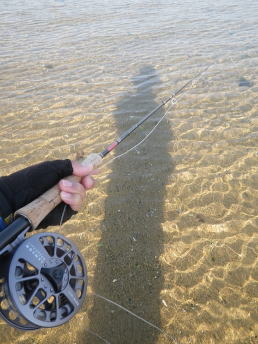

So I tried a clear intermediate line and it solved above two issues. But
because it is an intermediate line it sinks albeit slowly, and it sinks
not just the tip but from the butt - making mending and speedy recast difficult.
After trials and errors, I settled most happily with a clear tip line -
a rod length of clear intermediate section on the tip of a coloured floater
butt section. On its end I tie uluorocarbon 28, 15, 7lb in that order making
a 9ft leader & tippet. And these two rod length of clear sections are all I present in front of the
fish, keeping the coloured line away from their scope.

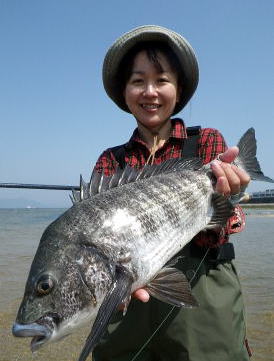
The path of the fly is an important factor too. Feeding breams tend to
have limited scope and either they don't notice your fly outside his vision,
or remain utterly indifferent. The challenge is to position your fly within
their small scope say 2 meters square in front of them, and do so without
spooking them away.
Any fish gets spooked when it sees something approaches. And they hate
something to approach from their back. The movement indicated in red arrow
in Fig. 3 are what you should avoid.
A favourable paths of the fly are those shown by green arrows in Fig. 4.
You want to let the bream to notice the fly, and as soon as the fish comes
for a look, the fly should move away to flee. That fleeing movement is
what fires up Bream's predatory instinct.

Hooking them up
Once they lock onto their prey, they start chasing it with persistence.
As the fly flees 3cm, they close in 3cm. You pull the fly by 5cm and sure
enough they dash 5cm. They would repeat this nibbling the fly, gradually
agitated and with bigger body movement. The taut line would impart the
impact of the bream chewing the fly but never lift up the rod yet - 9 out
of 10, your fly would end up flying to your back and the game is over.
Speed up the retrieve as the bream becomes excited, slow down the retrieve
if the bream loses interest or pretends as if. The art of teasing is the
name of the game.
Tease by 3cm first, then increase it to 5cm and 10cms. Be prepared to continue
this for 3 to 5 meters. When you see the bream's feeding instinct has gotten
the better of him, strip some 30cms to snatch the fly away from his sight
and stop. Bream will panic, worried if he's lost his meal, and the moment
when he finds it again, he will dash and nail it. Pull the line slowly
all the way to your back, and he is on.



Teasing
Assume you've thrown a perfect cast and the fish notices your fly. Bonefish
would rush nail it down but Breams won't. Well, some breams do rush to
the fly but with no exception they stop a few inches short and start a
careful inspection. They always do this even when they attack real crabs
or shrimps. Breams are wary predators. And mind you they have very discerning
eyes. 3 seconds of inspection will blow the cover off of the world's greatest
imitation. What you do is to pick the fly away from him a split second
before they blow the cover, and stop. Stop till the bream approaches again
for another look and again pick the fly away from him. Show the fly, but not for too long, move the fly away but not too far, to imitate a crab or shrimp in fright.
To do above with maximum accuracy, your rod tip must be pointing directly
to the target. With that set up, you can move the fly exactly an inch by
pulling the flyline one inch.
Choice of lines
Having done thus far all well, you still end up seeing off your target
shoots away as well as his half a dozen friends to the horizon. Very often
I noticed that stampede takes place even before the line hits the water.
Why?
I tried the clear floating line produced by Monic, which reduced the frequency
of that misery dramatically. Hats off to this unique product.
But I came to notice this line has its own disadvantages too. Firstly,
this is a floating line. And line floating on the surface causes more disturbances
spooking the breams. Secondly, again because this is a floating line, there
will be a pulling up effect - as you retrieve the flyline, it pulls leader
up which in turn pulls the fly up from the bottom. See the yellow line
in Fig 2 below.
Choice of flies
No doubt the best fly depends on the location and the seasons. In my observation
and in my part of Japan anyway, crab pattern and shrimp pattern seem to
work the best.
Like bonefish, Breams love to chase flies fleeing on the bottom. Therefore
the fly should have sufficient weight to prevent it from swimming up. Compared
with Bones, Breams do not like the sound of fly tapping into the water.
You cannot zero down that but should consider the balance between weight,
size and silhouette.
Crab flies are less desirable than shrimp patterns in ease of casting (and
tying for that matter) but bream seem to become more fixated to this chunky
meals than skinnier shrimps.
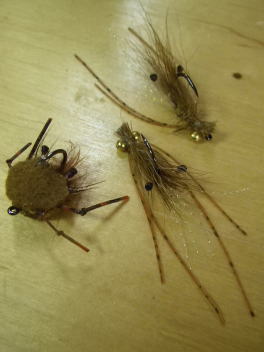
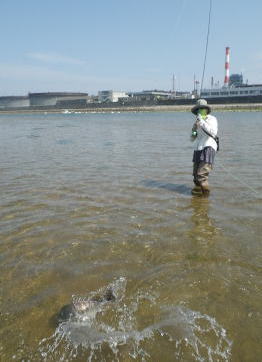
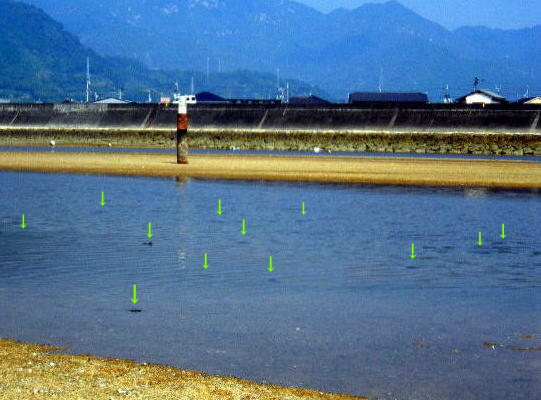
Approach
Once you are settled with the field choice, grab a polaroiding glasses and study the area in detail - this can best be done on a sunny summer day. When breams are not alarmed, they come onto surprisingly shallow waters often less than their own body depth. You often see their fins and tails flagging above the surface and that's a tell tale sign of happy breams enjoying the banquet.
They have acute senses and spook away at the first sign of an intruder.
You must keep your head low and sneak up - like any other fishing but particularly so in this game.
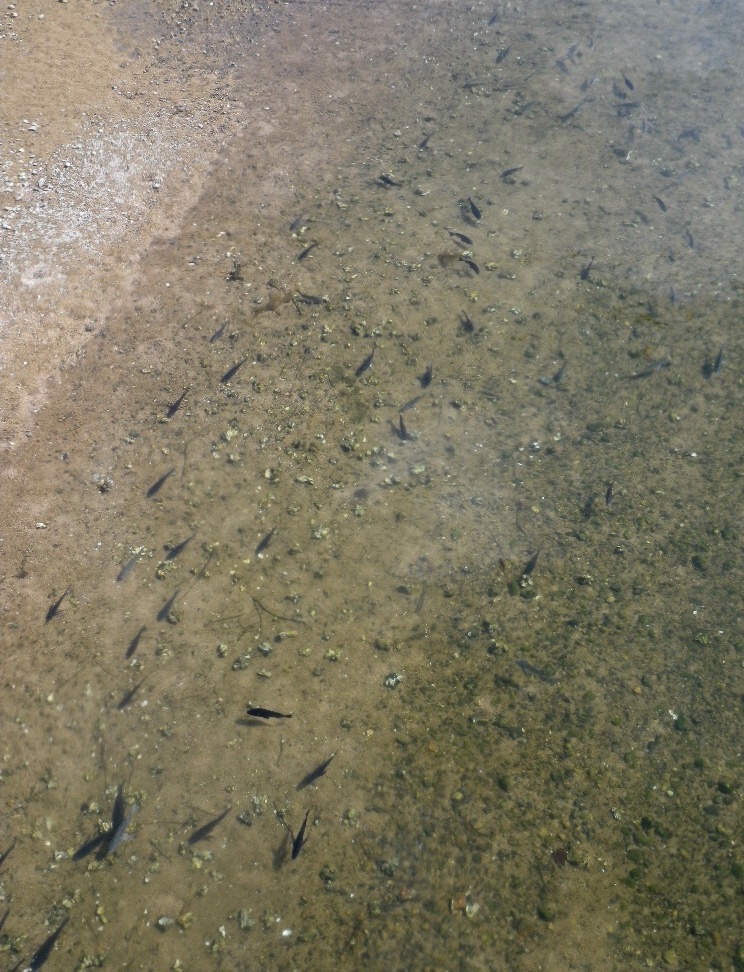
Field choice
First off they are by no means an easy target. Compared with such innocent
game like Bonefish, Breams are hopeless skeptics. They doubt, refuse and
spook away from the most delicately presented offering. Out of 100 sighted
bream a competent flyfisher probably catch one, maybe two. Therefore the
most important thing is to find a location where they are abundant. May sound such a simpleton matter but is the single most critical factor
in this game.
Once you spot a potential good field, try wading. Muddy flats are not suitable
as muddled water alerts the fish and makes sighting difficult. And the
flatter the ground, the better it is for the anglers to take ideal approach
angles. A smooth flat with sandy gravel bottom is the best set up.
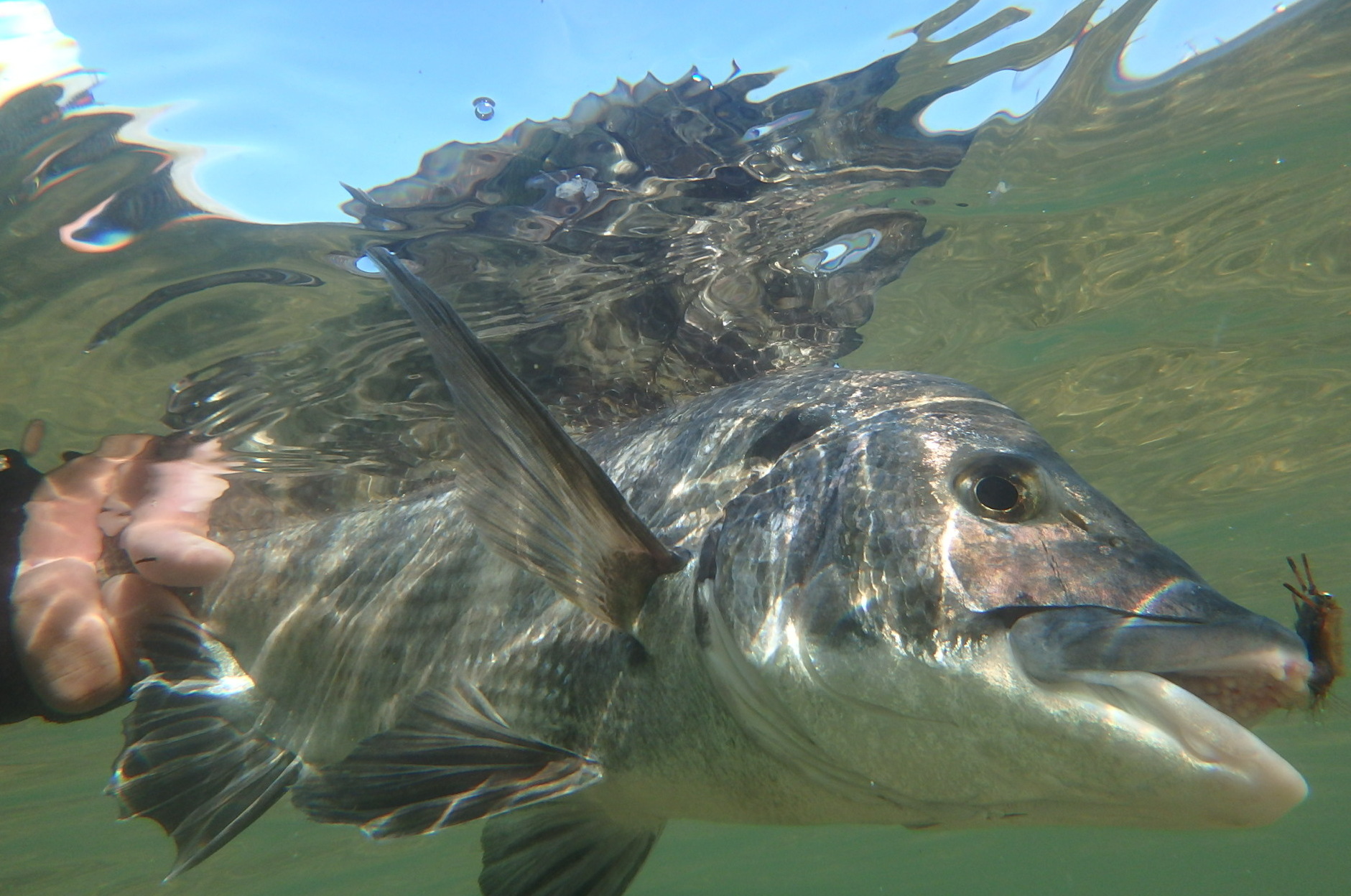
Black breams, or Chinu, as we call them in southern part of Japan, has
a stern countenance and a masculine body - suggesting an air of Samurai
warrior if I may romanticize it a bit.
Meanwhile they are glutton feeders that could live on just about anything.
In urban waterways they happily feed on human garbage. It is no surprise
they became our familiar neighbours but those people who attempted to catch
one, quickly find out they are extremely intelligent, spooky creatures.
I used to think you can only catch them with bai only after dark. Well,
not any longer!
 - Basic techniques -
- Basic techniques -









